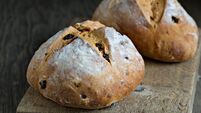Weekend food with Darina Allen: Wild foods in vogue

Wild foods have never been so much in vogue, they are all over restaurant menus and we love it, writes
Foraging has virtually become a national sport, young and old are scurrying about in woodlands and along the hedgerows in search of nuts, berries and wild mushrooms. It’s been a fantastic year for fungi, we got baskets and baskets of wild mushrooms, not just field mushrooms, but porcini, yellow legs, chanterelles and even a huge cauliflower mushroom proudly delivered by a particularly knowledgeable local forager. I’d never cooked one before so that was super exciting.
We used field mushrooms in every conceivable way, mushroom soup, mushrooms on toast, mushroom a la crème, mushroom risotto, and we made mushroom ketchup for the first time in over a decade.
Our farm around the Cookery School has been managed organically for more than 20 years now and this year Mother Nature rewarded us with a bounty of field mushrooms. We couldn’t collect them fast enough, several of the fields were literally white with mushrooms. We had such fun showing our grandchildren how to recognise and gather field mushrooms. For the first time in almost a decade the conditions were perfect — warm moist weather and chemical-free fields.
There’s also a bumper crop of blackberries. I’m not sure I’ve ever seen so many eager foragers scrabbling around in the brambles. Local children have been collecting the plump berries and we’re thrilled to buy them both for the Cookery School and the restaurant. There are a million delicious ways to use them. We all know that blackberry and Bramley apple is a winning combination on their own but add a few leaves of rose geranium and you have something sublime.
Earlier this year, 15-year-old Simon Meehan from Ballincollig was declared Young Scientist of the Year for his discovery that blackberries contain a non-toxic, organic, original antibiotic which is effective in killing Staphylococcus aureus, a bug that infects humans and is increasingly resistant to antibiotic treatment, especially when it comes in the form of the common hospital-acquired infection MRSA. So gorge yourself on blackberries while they last, they also contain loads of vitamin C, vitamin A, iron, magnesium and calcium.
My youngest grandchild Jago (two years old), can’t get enough of them, he’s like a kid in a candy shop gobbling them up like smarties off the blackberry bushes, ignoring the prickles in an effort to reach every last one.
Grandpoppy’s Mushroom Ketchup
It only makes sense to make mushroom ketchup on the rare years when there’s a glut of wild mushrooms in the fields. This is becoming less and less common because of the level of pesticides used in conventional farming. Occasionally though, when the weather at the end of the summer is warm and humid as it was this year, we get a flush of mushrooms, and we can’t bear to waste any of them.
Make a supply of mushroom ketchup, which keeps for years. You can dash it into game, beef, lamb and chicken stews and casseroles, shepherd’s pie, or just use it as you would soy sauce.
- As many wild field mushrooms as you can gather
- Salt For each 1.2 litres of ketchup, use:
- 10g whole peppercorns
- 7g whole ginger
- Half teaspoon allspice
- Quarter teaspoon ground cloves
- Half teaspoon mace
- 50ml whiskey or if you prefer omit the whiskey and add 1 tablespoon of best brandy to each bottle before sealing
- Put the mushrooms into a large basin. Sprinkle salt between each layer to extract juice. Steep for 24 hours, occasionally stirring and breaking the mushrooms.
- Allow to stand for a further 12 hours to settle the sediment.
- Pour into another vessel, leaving behind the sediment. Measure, strain and to every 1.2 litres of ketchup add the above ingredients. Bottle and seal.
- Mushroom ketchup keeps for years: I have some that is over five years old and is still perfect. The steeped mushrooms themselves can be composted or fed to the hens.
Wild Mushroom à la Crème on Toast
Mushroom à la crème is a fantastic all-purpose recipe, and if you’ve got a surplus of wild mushrooms, use those instead of cultivated ones. You can even use dried mushrooms. Mushroom à la crème keeps well in the fridge for four to five days and freezes perfectly.
Serves 8
- 50g (2oz) butter
- 175g (6oz) onion, finely chopped
- 450g (1lb) wild mushrooms (chanterelles, morels, ceps, false chanterelles or the common field mushroom), sliced
- Salt and freshly ground pepper
- Good squeeze of lemon juice
- 225ml (8fl oz) cream
- Freshly chopped parsley
- 1 tbsp freshly chopped chives (optional)
- Sourdough bread
Melt half the butter in a heavy saucepan until it foams. Add the chopped onion, cover and sweat over a gentle heat for five to 10 minutes or until quite soft but not coloured; remove the onions to a bowl.
Meanwhile cook the sliced mushrooms in a hot frying pan in the remaining butter, in batches if necessary. Season each batch with salt, freshly ground pepper and a tiny squeeze of lemon juice. Add the mushrooms to the onions in the saucepan, then add the cream and allow to bubble for a few minutes. Taste and correct the seasoning, and add the chopped herbs.
Toast or pan-grill the bread and pile the hot creamy mushroom mixture on top.
Enjoy immediately.
Hot tips
Grandmother’s Day: Don’t forget – Grandmother’s Day is coming up and tomorrow we’ll be celebrating it at Ballymaloe Cookery School. From noon to 5.30pm, Rebecca O’Sullivan of Granny Skills, Australia will demonstrate how to make flower petal tote bags. She will also talk about how to use edible flowers and herbs for health. Maria Walsh and Lydia Hugh-Jones will show us how to make butter and have a ‘disco butter making’ session with the children. There will also be a talk on bees to encourage young bee keepers. Plus much, much more. See www.slowfoodireland.com
Maria Walsh’s Blackberry Tincture
Blackberries are a rich source of antioxidants. Tinctures are easy and convenient to use.
Recycle an old jam jar — 290ml.
Three quarter fill the jar with wild blackberries, picked on a dry day.
Cover the berries with alcohol — vodka or brandy. For a non-alcoholic version use apple cider vinegar or kombucha vinegar.
Place the tincture in a dark cupboard. Shake the jar once a day and leave for six-eight weeks.
When ready, one could take a teaspoon every day or add to water, jazz up cocktails or add to water kefir.
Wild Mushroom and Thyme Leaf Tart
A really flavoursome tart, one of the few that tastes super warm or cold. Use cream! Both the flavour and texture are quite different if you substitute milk. Flat cultivated mushrooms also work well when field mushrooms are not available
Serves 6
- Rich Shortcrust Pastry
- 110g (4oz) plain white flour
- 50-75g (2oz-3oz) butter
- water to bind or a mixture of water and beaten egg
- 225g (8oz) wild mushrooms, flats
- 15g (½oz) butter
- 1 tbsp olive oil
- 1 tsp fresh thyme leaves
- 225ml (8fl oz) cream
- 2 eggs and 1 egg yolk, free range
- 50g (2oz) freshly grated Parmesan cheese or preferably Parmigiano Reggiano
- Flaky sea salt
- Freshly ground black pepper
- A good pinch of cayenne
Equipment
1 x 7 inch (18cm) flan ring or tin with pop up base (low sided)
Make the shortcrust pastry in the usual way.
Sieve the flour, cut the butter into cubes and rub into the flour with the fingertips. Keep everything as cool as possible; if the fat is allowed to melt, the finished pastry may be tough. When the mixture looks like coarse breadcrumbs, stop. Whisk the egg or egg yolk and add some water. Take a fork or knife (whichever you feel most comfortable with) and add just enough liquid to bring the pastry together, then discard the fork and collect it into a ball with your hands, this way you can judge more accurately if you need a few more drops of liquid. Although rather damp pastry is easier to handle and roll out, the resulting crust can be tough and may well shrink out of shape as the water evaporates in the oven. The drier and more difficult-to-handle pastry will give a crispier shorter crust.
Cover the pastry with cling film and leave to rest in the fridge for a minimum of 15 minutes. This will make the pastry much less elastic and easier to roll.
Allow to rest, line the flan ring and bake blind for 25 minutes.
Meanwhile chop the mushrooms finely, melt the butter, add the oil and fry the mushrooms on a very high heat. Add thyme leaves and season with salt and freshly ground pepper. Cook until all the juice has evaporated and then allow to cool.
Preheat the oven to 180C/350F/Gas Mark 4.
Whisk the cream in a bowl with the eggs and the extra egg yolk, stir in the cool mushrooms and the Parmesan cheese. Taste, add the pinch of cayenne and more seasoning if necessary. Pour into the pre-baked pastry case.
Bake in the preheated oven for about 30-40 minutes or until the filling is set and the top delicately brown.
Serve with a good green salad
Note: Tiny mushroom quiches may be served straight from the oven as appetisers before dinner or for a drinks party.
Apple, Sloe and Sweet Geranium Jelly
This apple jelly recipe is the most brilliant mother recipe to add all sorts of flavours. If you have lots of sloes increase the quantity to half apples and sloes. Serve on scones, with game, pork, duck or guinea fowl.
Makes 6-7 pots
- 2.2kg crab apples or Bramley Seedlings
- 450g sloes
- 2.7 litres water
- 6-8 large sweet geranium leaves (Pelargonium Graveolens)
- plus extra as needed.
- 2 lemons, unwaxed organic
- sugar
Wash the apples and cut into quarters, no need to peel or core. Windfalls may be used, but make sure to cut out the bruised parts. Put the apples in a large saucepan with the sloes and geranium leaves, the water and the thinly pared rind of the lemons, cook until the apples and sloes dissolve into a ‘mush’, approximately two hours.
Turn the pulp into a jelly bag and allow to drip until all the juice has been extracted — usually overnight. Measure the juice into a preserving pan, allow 450g sugar to each 600ml of juice. Heat the sugar in a moderate oven 180C/gas mark 4 for about 10 minutes. Squeeze the lemons, strain the juice and add to the preserving pan, add a few more geranium leaves if the flavour is still very mild. Bring to the boil and add the sugar. Stir over a gentle heat until the sugar is dissolved. Increase the heat and boil rapidly without stirring for about eight-10 minutes. Remove the geranium leaves. Skim, test and then pour the jelly into sterilised jars, put a sweet geranium leaf in each jar. Cover and seal immediately.








